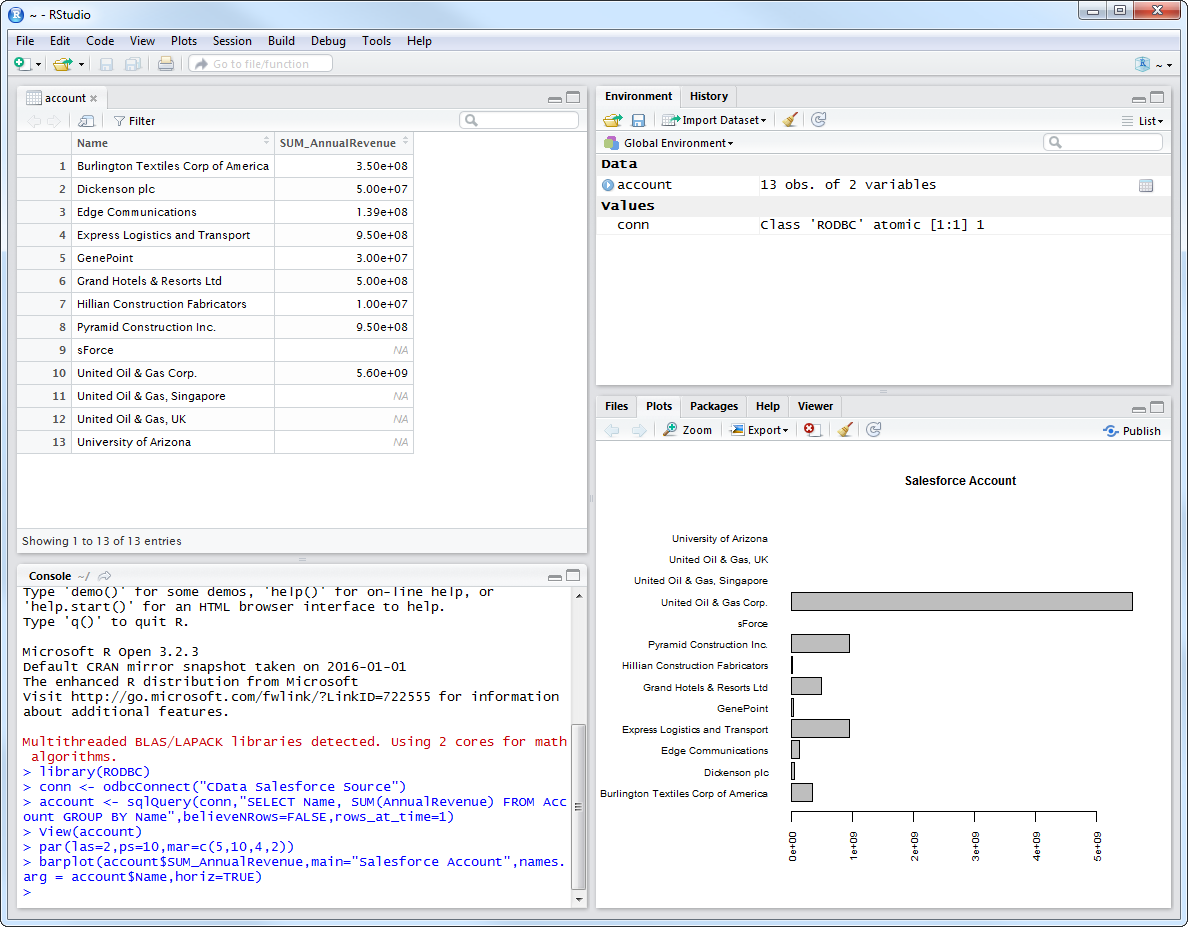Model Context Protocol (MCP) finally gives AI models a way to access the business data needed to make them really useful at work. CData MCP Servers have the depth and performance to make sure AI has access to all of the answers.
Try them now for free →Analyze Quickbase Data in R
Create data visualizations and use high-performance statistical functions to analyze Quickbase data in Microsoft R Open.
Access Quickbase data with pure R script and standard SQL. You can use the CData ODBC Driver for Quickbase and the RODBC package to work with remote Quickbase data in R. By using the CData Driver, you are leveraging a driver written for industry-proven standards to access your data in the popular, open-source R language. This article shows how to use the driver to execute SQL queries to Quickbase data and visualize Quickbase data in R.
Install R
You can complement the driver's performance gains from multi-threading and managed code by running the multithreaded Microsoft R Open or by running R linked with the BLAS/LAPACK libraries. This article uses Microsoft R Open (MRO).
Connect to Quickbase as an ODBC Data Source
Information for connecting to Quickbase follows, along with different instructions for configuring a DSN in Windows and Linux environments.
User Authentication Method
To authenticate with user credentials, specify the following connection properties:
- Set the User and Password.
- If your application requires an ApplicationToken;, you must provide it otherwise an error will be thrown. You can find the ApplicationToken under SpecificApp > Settings > App management > App properties > Advanced settings > Security options > Manage Application Token.
User Token Authentication
To authenticate with a user token, specify the following connection properties:
- Set UserToken and you are ready to connect. You can find the UserToken under Quick Base > My Preferences > My User Information > Manage User Tokens.
When you configure the DSN, you may also want to set the Max Rows connection property. This will limit the number of rows returned, which is especially helpful for improving performance when designing reports and visualizations.
Windows
If you have not already, first specify connection properties in an ODBC DSN (data source name). This is the last step of the driver installation. You can use the Microsoft ODBC Data Source Administrator to create and configure ODBC DSNs.
Linux
If you are installing the CData ODBC Driver for Quickbase in a Linux environment, the driver installation predefines a system DSN. You can modify the DSN by editing the system data sources file (/etc/odbc.ini) and defining the required connection properties.
/etc/odbc.ini
[CData QuickBase Source]
Driver = CData ODBC Driver for Quickbase
Description = My Description
User = user@domain.com
Password = password
Domain = myinstance.quickbase.com
ApplicationToken = bwkxrb5da2wn57bzfh9xn24
For specific information on using these configuration files, please refer to the help documentation (installed and found online).
Load the RODBC Package
To use the driver, download the RODBC package. In RStudio, click Tools -> Install Packages and enter RODBC in the Packages box.
After installing the RODBC package, the following line loads the package:
library(RODBC)
Note: This article uses RODBC version 1.3-12. Using Microsoft R Open, you can test with the same version, using the checkpoint capabilities of Microsoft's MRAN repository. The checkpoint command enables you to install packages from a snapshot of the CRAN repository, hosted on the MRAN repository. The snapshot taken Jan. 1, 2016 contains version 1.3-12.
library(checkpoint)
checkpoint("2016-01-01")
Connect to Quickbase Data as an ODBC Data Source
You can connect to a DSN in R with the following line:
conn <- odbcConnect("CData QuickBase Source")
Schema Discovery
The driver models Quickbase APIs as relational tables, views, and stored procedures. Use the following line to retrieve the list of tables:
sqlTables(conn)
Execute SQL Queries
Use the sqlQuery function to execute any SQL query supported by the Quickbase API.
sampletable_1 <- sqlQuery(conn, "SELECT Id, Column1 FROM SampleTable_1 WHERE Column2 = '100'", believeNRows=FALSE, rows_at_time=1)
You can view the results in a data viewer window with the following command:
View(sampletable_1)
Plot Quickbase Data
You can now analyze Quickbase data with any of the data visualization packages available in the CRAN repository. You can create simple bar plots with the built-in bar plot function:
par(las=2,ps=10,mar=c(5,15,4,2))
barplot(sampletable_1$Column1, main="Quickbase SampleTable_1", names.arg = sampletable_1$Id, horiz=TRUE)


